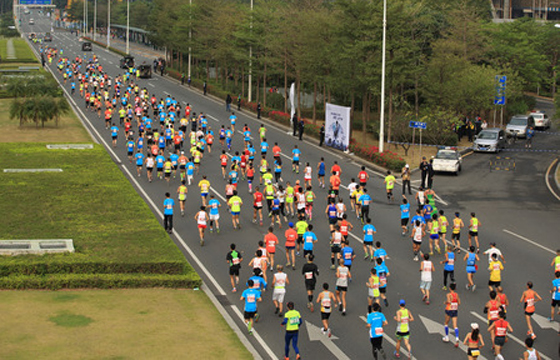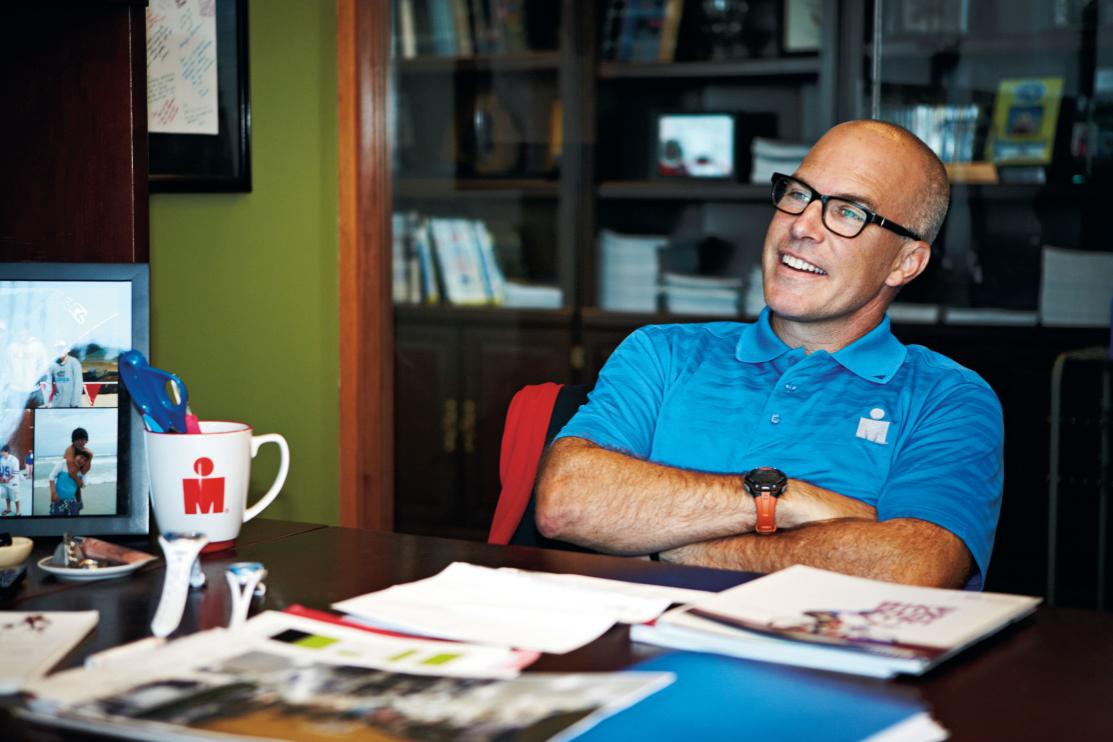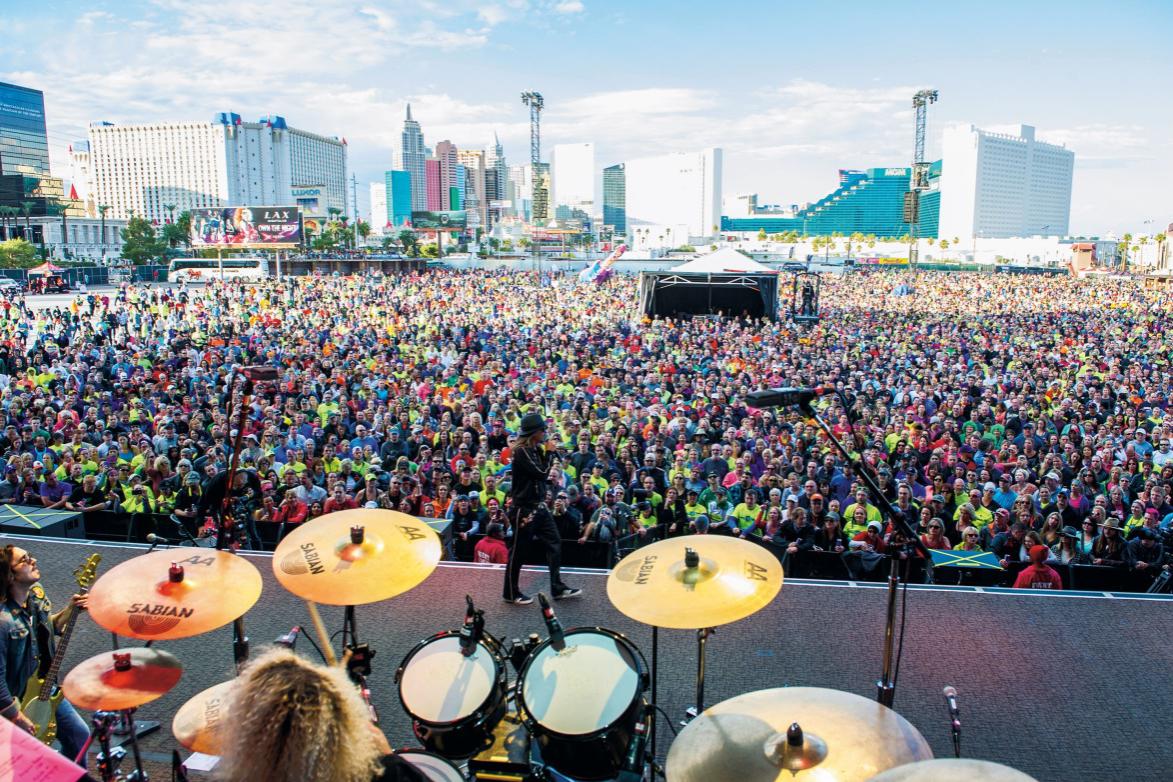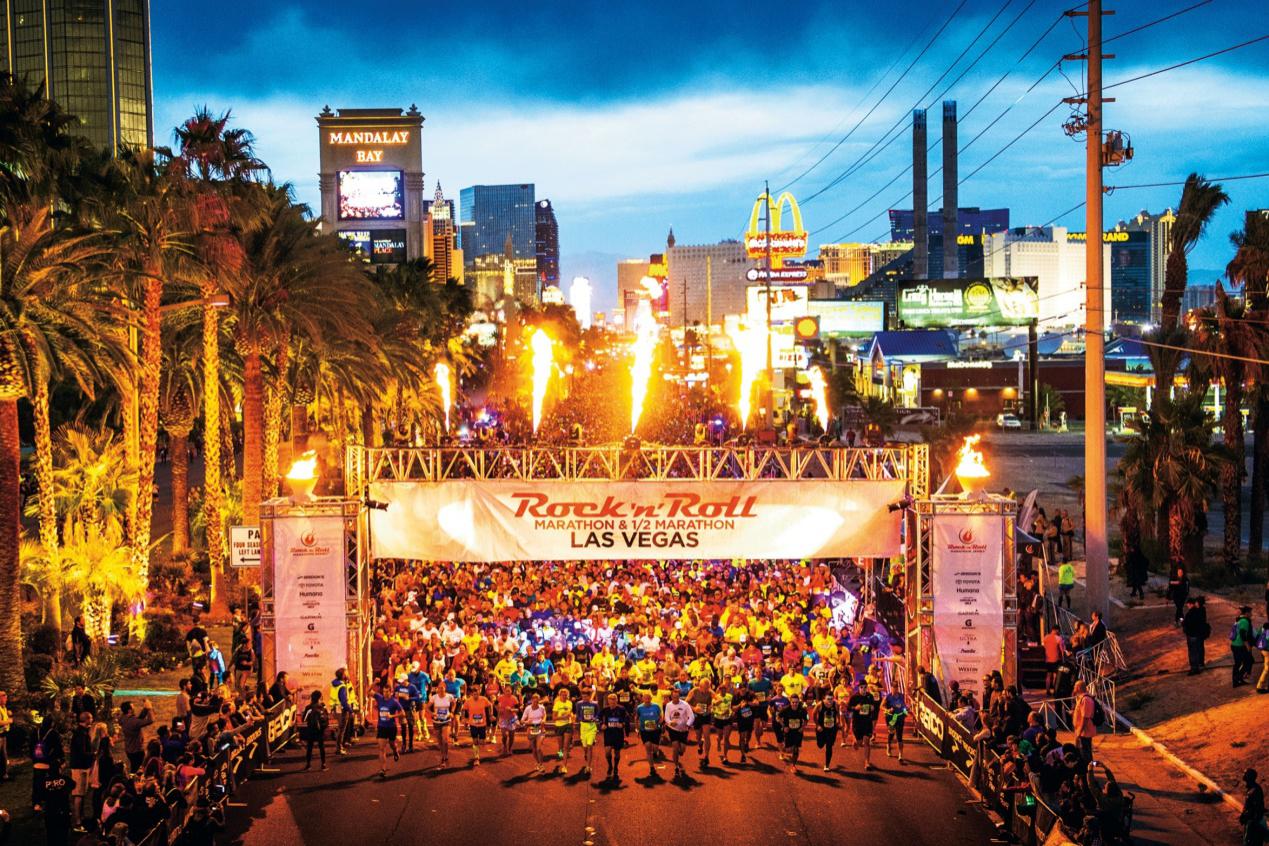揭秘中国耐力运动帝国

|
16年前,安德鲁·梅西克是一位处于上升期的NBA高管,但也早早地出现了中年人的那些毛病。经常出差和长时间的工作让他体重上升,容易疲劳而且总是背疼。 作为高中竞赛运动员和加州大学戴维斯分校英式橄榄球队员,梅西克此时重新回归到了运动中。他开始在纽约中央公园进行短程自行车练习,然后逐步增加骑行长度。他自学了竞赛性游泳。2005年,他遇到了自己的最爱——铁人三项。“铁人”是业余耐力运动员的最高标准,这项运动包括3.8公里游泳、180公里自行车和42.195公里跑步,中间没有停歇。 随着梅西克进行训练,他的体重从最高时的210磅(94.5公斤)降至仅170磅(76.5公斤),长期以来的背疼也得到了缓解。现在,53岁的梅西克已经完成了三次全程铁人三项,并经常参加短程铁人三项比赛。最重要的是比赛让他从情感上得到了满足,他说:“它满足了人们的一种基本需求,人们想知道‘我能做到吗?’” 梅西克目前的工作是劝说另外数百万人来回答这个问题。2011年,他成为世界铁人公司首席执行官,这家公司在全球范围内组织铁人三项等体育赛事。2015年,中国大型综合集团万达传媒收购了WTC。今年,万达传媒又收购了全球最大的马拉松和半程马拉松组织机构。作为这些业务的总负责人,梅西克如今面临着一个巨大挑战,让中国不断增多而且终日坐在办公桌前的中产阶层产生对这些体育项目的需求。 和其他趋于成熟的产业一样,耐力体育也在中国寻找活力的源泉。咨询机构IBISWorld的数据显示,在美国,耐力体育市场的规模接近20亿美元(133亿元人民币),但这个市场最大的一块儿,也就是马拉松和半程马拉松已经停止增长。中国的耐力体育市场较小,但已经出现实现初步繁荣的迹象。2015年,在中国田径协会注册的马拉松赛事有134项,去年这个数字增至328项(美国约为1200项)。此外,中国政府也把重心放在了体育和健身产业上,并将此举作为以消费品和服务为导向的经济转型的一部分。同时,所有主要体育项目中的商业机构都希望参与到这股潮流之中。 |
Sixteen years ago, Andrew Messick was an executive on the rise at the National Basketball Association—and suffering from early-onset middle-aged blahs. Constant travel and long hours had led him to pack on the pounds, leaving him easily tired and plagued with back problems. That’s when the former high school track athlete and UC–Davis rugby player rediscovered exercise. He started with short bike rides in New York City’s Central Park, then graduated to longer excursions. He taught himself to swim competitively. And by 2005 he had found his obsession: Ironman triathlons. “Ironmans” are the gold standard for amateur endurance athletes: Each consists of a 2.4-mile swim, a 112-mile bike ride, and a 26.2-mile marathon—with no breaks. As Messick trained, his weight fell as low as 170 pounds from a peak of 210, relieving his long-suffering back. Messick, 53, has now done three full-length Ironmans and competes frequently in shorter triathlons. Above all, he says, competing satisfies him emotionally: “It fills an elemental need in people, which is to know, ‘Can I do it?’ ” Today it’s Messick’s job to persuade millions more people to answer that question. In 2011 he became CEO of World Triathlon Corp. (WTC), which organizes Ironman and other sporting events worldwide. In 2015, WTC was acquired by Chinese mega-conglomerate Dalian Wanda, and this year, Wanda bought the world’s largest organizer of marathons and half-marathons. Messick, who oversees the combined operation, now faces an Olympian challenge: generating demand for such events among China’s rising cohort of middle-class, deskbound consumers. Like other maturing industries, endurance sports are looking to China for invigoration. Endurance events are a nearly $2 billion market in the U.S., according to IBISWorld, but its biggest category—marathons and half-marathons—has stopped growing in the States. In China the market is relatively tiny, but there are signs of an incipient boom. In 2015 there were 134 marathon events registered by the China Athletics Association; last year there were 328. (There are about 1,200 in the U.S.) What’s more, China’s government has thrown its weight behind the sports and fitness industries, as part of an effort to reorient its economy around consumer goods and services—a trend that business interests in just about every major sport hope to tap. |

|
亿万富翁王健林的大连万达集团也希望在这个领域觅得一席之地。万达斥资约6.50亿美元(43.2亿元人民币)从私募股权公司Providence Equity Partners手中收购了WTC。在铁人三项以外,万达还将其他几十种耐力体育项目收入囊中。其中最引人注目的是今年6月对Competitor Group Inc.的收购,后者是摇滚马拉松的母公司。这项赛事已经进入29个市场,参赛人数达60万。得益于这些收购,万达已经悄悄成为全球耐力体育领域的主导企业,它收购的这些公司都成了万达体育控股的一部分。 万达体育正开始在中国一试身手。今年中国将举办五次铁人三项比赛,明年将举办六次。中国的首届摇滚马拉松将于今年10月28日在成都这个有700万人口的城市举行,美国联合航空将成为这次赛事的主赞助商。 |
Dalian Wanda, owned by billionaire Wang ¬Jianlin, wants to get in on the ground floor. Wanda bought Ironman for about $650 million from private equity firm Providence Equity Partners. Wanda has also assembled a portfolio of dozens of endurance races outside the Ironman universe. Most notably, in June it scooped up Competitor Group Inc. (CGI), parent company of the Rock ‘n’ Roll marathons, which fields races in 29 markets, with 600,000 participants. Thanks to these acquisitions, now part of Wanda Sports Holding, Wanda has quietly become the dominant global company in endurance sports. The new entity is blazing a trail in China. The country will host five Ironman events this year, and six in 2018. And China’s inaugural Rock ‘n’ Roll marathon and half-marathon will take place Oct. 28 in Chengdu, a city of 7 million, with United Airlines as its major sponsor. |

|
但万达希望不断扩张,让自身业务远涉海外。万达体育在全球拥有250多项赛事的主办权,其收入来自报名费、公司赞助、商品销售和转播权。梅西克的设想是让摇滚马拉松和铁人三项相互促进——摇滚马拉松可以把参赛者导向精英型、成本更高的铁人三项赛事;WTC则可以和摇滚马拉松分享其专业能力,后者在资金和组织方面都有困难。信用评级公司穆迪预计,WTC和摇滚马拉松今年将实现收入3亿美元(19.95亿元人民币),并将受益于“明显的成本协同效应”。如果中国市场的潜力确实像万达相信的那样,这个收入数字就有望在10年时间里轻松增长一倍。 但就像马拉松比赛一样,个头大小并不能保证成功。耐力竞赛领域正变得越来越拥挤,“最强泥人”等短距离障碍赛一直在夺取市场份额;在资金充裕的理查德·布兰森资助下,市场新星Virgin Sport也参与到了竞争中,该公司打算推出一系列“节日型”赛事,把瑜伽课和音乐会跟耐力赛事融合在一起。梅西克需要创新,以便让万达推出的赛事脱颖而出。他问道:“你怎么才能抓住参赛者的想象力,让他们有理由在早上4点半起床并参加训练呢?”回答这个问题需要体力。 |
But Wanda wants to keep expanding far beyond its home country. The combined entity has a roster of more than 250 events globally, from which it earns revenue via entry fees, ¬corporate sponsorships, merchandise, and broadcast licenses. Messick envisions Rock ‘n’ Roll and Ironman boosting each other: Rock ‘n’ Roll races can funnel athletes toward the more elite, -expensive Ironmans; WTC, meanwhile, can share expertise with Rock ‘n’ Roll, which has struggled financially and organizationally. ¬Credit rating firm Moody’s says it expects WTC and Rock ‘n’ Roll to rake in $300 million this year thanks to “meaningful cost synergies.” If China’s potential is as great as Wanda believes, revenue could easily double in a decade. But just as in marathon running, size doesn’t guarantee success. The endurance-race field has grown increasingly crowded: Shorter obstacle-course events like Tough Mudder have been stealing market share; Virgin Sport, an upstart financed by deep-pocketed Richard Branson, has leaped onto the track with a slate of “festivals” that add yoga classes and concerts to the endurance-race mix. Messick will need to innovate to make Wanda’s offerings stand out. “How do you continue to capture the imagination of athletes and give them a reason to get up at 4:30 in the morning and train?” he asks. Answering that question will take stamina. |

|
作为一项要做出很大个人牺牲的运动,值得注意的一点是摇滚马拉松的成功源于让马拉松变得不那么孤单的努力。这项赛事的灵感出现在1997年,参赛者蒂姆·墨菲在圣迭戈之心马拉松比赛中突然觉得跑不动了,并且希望能有音乐来推动自己完成最后的几公里赛程。第二年,他在圣迭戈举行了首届摇滚马拉松。墨菲的想法是把赛跑变成大规模社区聚会,在比赛沿线安排几十支乐队,从而给跑者带来动力,也让观赛者得到享受。 跑步爱好者很快就接受了这个概念。举例来说,每年都有数百人打扮成猫王来参加拉斯维加斯马拉松。随着摇滚马拉松流行起来,组织团队很快就获得了几乎没有其他举办方可以比肩的优势,那就是用统一的品牌来鼓励大众在多个城市参加多项比赛。实际情况证明,这样的思路对投资公司Falconhead Capital来说不可抗拒。这家公司在2008年收购了摇滚马拉松所有者Elite Racing,随后将它和自己的其他业务合并,从而建立了CGI。 |
In a sport associated with intense self-sacrifice, it’s noteworthy that the Rock ‘n’ Roll series’ success sprang from an effort to make marathons less lonely. The theme was inspired in 1997, when runner Tim Murphy found himself hitting the wall during the Heart of San Diego marathon and wishing he had a musical pick-me-up to power him through the final miles. The next year he organized the first Rock ‘n’ Roll race, in San Diego. The idea was to turn races into extended block parties, with a few dozen bands along the route to energize runners and keep onlookers entertained. Runners quickly warmed to the concept: Every year, for example, hundreds dress as Elvis Presley for the Las Vegas marathon. As it caught on, the Rock ‘n’ Roll team soon had an edge few organizers could match: a uniform brand that encouraged large groups to participate in multiple races in multiple cities. That math proved irresistible to investment firm Falconhead Capital, which bought Rock ‘n’ Roll owner Elite Racing in 2008 and merged it with other properties to create CGI. |

|
在新资金支持下,CGI开始大举收购。它在2008年买下了拉斯维加斯现有马拉松赛事的主办权,2009年进入丹佛,随后涉足国际市场,将业务扩展到了马德里、爱丁堡、蒙特利尔和里斯本。新的赛事都很成功,CGI也迅速成为这个高度分散、高度本地化的产业中第一家真正的全球性组织机构。同时,赞助商得到了诱人的目标受众。据CGI介绍,60%的参赛者为女性,家庭收入至少达10万美元(66.5万元人民币)的参赛者占一半。更多大公司加入了赞助行列。据报道,2012年CGI实现收入1.26亿美元(8.38亿元人民币),过去五年的销售额年增幅为26%。 但CGI的核心市场即将遭遇瓶颈。该公司的成长和美国马拉松赛事的飞速增长同步——2014年完赛人数为55.06万,比1998年增加63%。但实际情况证明这是个很高的水平,原因是婴儿潮一代随着年龄的增长而退出比赛,年轻的运动爱好者则被CrossFit健身和SoulCycle动感单车等存在竞争关系的运动所吸引。行业协会Running USA的数据显示,2016年参加马拉松赛事的美国人降至50.76万(半程马拉松赛参赛人数也在下降,CGI则是几项半程马拉松赛事的举办方。)Running USA首席执行官里奇·哈什巴杰说:“繁荣期的增长速度不会持久,[赛事]供给已经超过了需求。” 此前稳健的CGI甚至在这之前就已经变得步履蹒跚。2012年CGI的所有权发生了变更,私募股权公司Calera通过杠杆融资对其实施了收购,导致CGI负债累累。CGI是如此渴望增长,以至于它在首次举办比赛时就会召集大量参赛者,而不是以小规模开始,然后逐步成长。2015年,CGI的首届布鲁克林半程马拉松就吸引了1.75万名参赛者,但陷入混乱的安检点和过于拥挤的赛道毁了这次比赛。CGI也变得贪婪起来,甚至在拉斯维加斯的马拉松赛上出售过移动厕所VIP使用权。梅西克的解读是,管理层变得更关注投资者的预期,而不是参赛者。 作为一家碰上了市场萎缩而自己又过度扩张的公司,麻烦迎面而来。由于报名人数骤减,CGI不得不砍掉很多比赛,其中包括丹佛马拉松和普罗维登斯以及圣彼得堡的半程马拉松。这家资金匮乏的公司再次被贷款人所控制,后者把它转让给了万达,但未披露交易金额。 2008年,Providence Equity以约8500万美元(5.65亿元人民币)的价格收购了WTC和它的那些铁人三项赛事,比Falconhead收购摇滚马拉松晚了几个月。在两家被收购的公司中,WTC似乎一直处于落后位置,直到它聘请了梅西克。 在糕点公司Sara Lee和麦肯锡咨询公司干了一段时间后,梅西克从2000年开始进入了体育行业。作为NBA International高级副总裁,他把NBA的业务扩展到了包括中国在内的海外市场(梅西克随后进入了赛事推广机构AEG,后者和NBA在中国建立了合资公司)。梅西克说,他记得最牢的教导来自NBA前总裁大卫·斯特恩和现任总裁萧华,他们让梅西克认识到了不偏离品牌内涵的重要性,甚至是在面对扩张压力的时候。萧华告诉《财富》杂志:“安德鲁觉得如果我们不能按一定的标准来做某件事,那就不应该去做它。” 品牌自律成为梅西克在铁人三项领域中的核心。2011年,他成为WTC首席执行官。当时WTC授权了几十项赛事但不负责指导,从而使这项赛事的执行出现了不一致的情况。梅西克收回了这些授权。同时,他迅速进行扩张,通过举办更多的70.3铁人三项赛(也就是半程赛,传统铁人三项赛的长度为140.6英里)来扩大这项运动的影响力。他还抓住了销售商品的机会,比如说,铁人品牌的天美时手表目前已经成为销量最大的运动手表。梅西克上任三年后,WTC的收入增长了六倍,达到1.50亿美元(9.975亿元人民币)。 梅西克还建立了完善的消费者关系管理数据库,用于提高消费者的忠诚度。铁人三项赛事平均参赛人数约为2500人,报名费约700美元(4655元人民币,而马拉松比赛报名费接近125美元,也就是831元人民币)。许多参赛者把铁人三项视为“比赛一次足矣”的项目,梅西克却想让更多爱好者多次参赛。由于愿意参赛的人数较少,这个目标至关重要。梅西克说,消费者关系管理数据库留住了更多人——在2016年参加过铁人三项赛的选手中,约41%的人今年还会再参赛一次。 同时,梅西克的职业伦理得到了好评。Providence Equity负责铁人三项业务的董事总经理戴维斯·诺埃尔说:“他是一位让部下士气高涨的领导者,而且热爱这项运动。”参赛者回报了梅西克的这份热爱——今年将有约26万人参加全程和半程铁人三项赛,几乎是2011年参赛人数的两倍。 万达显然也很喜欢梅西克。梅西克说,收购WTC以来,万达基本上让他自行管理(除了梅西克,万达未让其他高层接受采访)。在万达集团宏大而又可能让人困惑的扩张计划中,万达体育显然是一个关键组成部分。 万达集团曾以商业地产为重点,现在则收购了许多完全不同的业务。除了WTC以及马德里竞技足球俱乐部的股份,万达还拥有传奇影业和AMC院线的多数股权。在中国,有一批万达这样的综合型集团,有些人认为它们的负债水平已经给中国经济带来了系统性风险。今年夏天,万达迫于政府压力出售了一些资产。不过,王健林的目标一直都很明确,那就是让万达的收入从2016年380亿美元(2527亿元人民币)升至2020年的1000亿美元(6650亿元人民币),同时到2018年让娱乐、零售和体育等消费类业务占销售额的三分之二。 被万达收购前,CGI就一直在扩展自己的马拉松版图。世界马拉松大满贯联盟由六项赛事组成,举办地分别为纽约、芝加哥、波士顿、伦敦、柏林和东京,它们吸引着顶尖专业马拉松选手。今年4月,万达宣布将和WMM进行为期10年的合作。按照合作协议,万达将在三年内为WMM增添一项亚洲赛事,而且有可能把WMM带到非洲。 WMM的赛事标准严格而明确,而且无所不包,比如赛道上的水站数量,再比如到机场的距离。但在冠名赞助商制药公司雅培资助下,WMM希望把参赛者范围延伸到精英运动员以外。纽约路跑协会主席、纽约马拉松赛事总监彼得·西亚克西亚说:“雅培两年前加入进来时,他们就希望更注重大众参与。” 大众参与对万达的收入来说很重要。美式橄榄球或足球等热门运动的赞助商支付溢价是为了接触到广大电视观众,和它们的不同点在于,马拉松赞助商的付费目的是和参赛者及其家庭和朋友这个精英圈子建立联系。梅西克认为中国可以极大地拓宽这个圈子,他在中国业余选手身上看到了热切的期盼。举例来说,2015年参加铁人三项赛事的中国选手有400名,2016年这个数字增至2800人。 让西方品牌出现在中国的耐力体育赛事中有合理的商业逻辑。西方奢侈品牌对中国消费者有吸引力,特别是对不熟悉的产品。这是WTC和摇滚马拉松一直用自己的名字进行运营的原因之一。俄亥俄大学体育管理专业教授、铁人三项爱好者诺姆·奥赖利说:“万达可不傻——这些都是投资。他们想要的是有用的品牌。”一个令人鼓舞的迹象是,阿迪达斯去年签下了一份两年期合同,将为中国的一些铁人三项赛事提供赞助,同时正在商讨2018年赛事的赞助事宜。 为保持这样的发展势头,万达需要通过聪明的营销让耐力体育更牢固地在中国文化土壤中扎根,同时避免出现万达接手前摇滚马拉松赛事的过度扩张问题。 此外,摇滚马拉松系列赛事需要管理层倾注更多的心血。梅西克说,鉴于65%的参赛者现在都带着耳机,听不到沿途乐队的声音,举办方得重新考虑比赛的形式(一种可能性是向参赛者播放有品牌的曲目,从而获得收入)。梅西克还需要跟上这项运动的科技竞赛脚步。纽约马拉松冠名赞助商印度的塔塔咨询服务公司已经开发出一款成熟app,可以实时追踪参赛者的精确位置。西亚克西亚指出,通过科技来实现社区建设是这项运动接下来要开拓的领域,“跑步的社交性已经远高于以往任何时候”。 摇滚马拉松最终可能要把精力集中到它最好的那几项赛事上,梅西克也暗示,可能会把更多比赛列入“备砍”范围。他说:“你必须热爱长跑比赛,但也要为说‘我们救不了它’做好准备。”不过,他相信运动的神秘感会让这些赛事保持蓬勃生机。在人们看来,马拉松和铁人三项都很神秘,几乎从一开始就是这样。铁人三项完赛选手的排名是具有独占性,以至于许多人都在身上纹了赛事标识。梅西克说:“这些比赛对许多人来说都意味着真正巨大的挑战。”迎接这项挑战的选手越多,他的工作就会变得越容易。(财富中文网) 本文将刊登在2017年10月1日出版的《财富》杂志上,题为《创建耐力运动帝国》。 译者:Charlie 审校:夏林 |
Backed by new capital, CGI went on a shopping spree: It bought existing marathons in Las Vegas in 2008 and Denver in 2009, then went international with acquisitions in Madrid, Edinburgh, Montreal, and Lisbon. It generally turned its new races into successes, and CGI soon became the first truly global organizer in a highly fragmented, localized industry. Sponsors, meanwhile, got a tantalizing target audience: According to CGI, 60% of its runners are women, and half have household income of at least $100,000. More big companies joined its roster, and by 2012, CGI reportedly had revenue of $126 million, with sales up 26% annually over the preceding five years. But CGI’s core market was about to bonk. Its ascent coincided with a meteoric rise in U.S. marathon running: The number of finishers climbed 63% from 1998 to 2014, to 550,600. That proved to be a high-water mark, however, as baby boomers aged out and competing trends like CrossFit and SoulCycle attracted younger athletes. Participation tumbled to 507,600 in 2016, according to Running USA, an industry association. (Half-marathons, of which CGI operates several, also saw a decline.) “Growth during the boom was unsustainable, and supply [of races] was outpacing demand,” says Rich Harshbarger, Running USA’s CEO. Even before then, the formerly sure-footed CGI had begun to stumble. The company changed ownership in a 2012 leveraged buyout by private equity firm Calera that left it with substantial debt. So hungry was CGI for growth that it would drum up huge turnouts for inaugural races, rather than start small and work out the kinks. The company’s first Brooklyn Half Marathon, in 2015, drew 17,500 runners but was marred by logistical snafus such as bag-check chaos and an overcrowded course. The company also got greedy: At one point, CGI sold VIP access to porta-potties at the start area of the Vegas marathon. Messick’s take: Management had become more focused on the expectations of investors than on runners. As an overextended company collided with a contracting market, troubles came to a head. CGI had to ax a number of races, including the marathon in Denver and half-marathons in Providence and St. Petersburg, as registration plummeted. The cash-strapped company ultimately reverted to control of its lenders, who sold it, for an undisclosed sum, to Wanda. Providence Equity bought WTC and the Ironman races for some $85 million in 2008, a few months after Falconhead bought Rock ‘n’ Roll. WTC seemed like the laggard of the two—until it hired Messick. Messick began working in sports in 2000 after stints at Sara Lee and the McKinsey consulting firm. As senior vice president of NBA International, he spearheaded the league’s business expansion into overseas markets, including China. (He later worked for AEG, helping that event promoter build joint ventures with the NBA in China.) Messick says his most memorable mentorships came from former NBA commissioner David Stern and current commissioner Adam Silver; they taught him the importance of not straying from what a brand stands for, even when facing pressure to expand. “Andrew felt if we couldn’t do something to a certain standard, we shouldn’t do it,” Silver tells Fortune. Brand discipline became central to Messick’s approach at Ironman. In 2011, when he became CEO, there were dozens of races that WTC licensed but didn’t supervise, creating inconsistencies in how they were executed; Messick reclaimed those licenses. At the same time he expanded rapidly, widening the brand’s appeal by launching more “70.3” races (triathlons half the length of a traditional, 140.6-mile Ironman). He also pounced on merchandising opportunities; the Ironman-branded Timex, for example, is now a top-selling sports watch. In Messick’s first three years, Ironman’s revenue rose sevenfold, to $150 million. Messick also created a sophisticated customer relationship management (CRM) database to help build customer loyalty. Ironman events average about 2,500 racers, with entry fees around $700 (marathon fees are closer to $125). Many racers treat triathlons as “one and done” achievements, but Messick wanted more athletes to do multiple Ironmans—a crucial goal, given the small pool of people willing to compete. Messick says the CRM system has increased retention: Some 41% of 2016’s Ironman athletes will compete in another event this year. Messick’s work ethic, meanwhile, drew raves. “He’s a leader who inspires the troops and loves the sport,” says Davis Noell, the Providence Equity managing director who oversaw Ironman. And athletes reciprocated that love: About 260,000 people will race in full-length and “70.3” Ironmans this year, almost twice as many as in 2011. Wanda appears to love Messick too: Since it bought WTC, the executive says, the company has largely left him to his own devices. (Wanda declined to make executives other than Messick available for interviews.) But Wanda Sports is clearly a key component in its parent company’s ambitious, if puzzling, expansion. Once focused mostly on commercial real estate, Wanda has been on a buying spree of disparate businesses. In addition to WTC and a stake in soccer’s Club Atlético de Madrid, the company owns film studio Legendary and a majority interest in the AMC theater chain. Wanda is part of a group of Chinese conglomerates that have piled up debt to the point where some view them as posing systemic risk to China’s economy; this summer, under political pressure, Wanda sold off some assets. Still, Wang Jianlin has been clear about his ambitions: Wanda is gunning for $100 billion in revenue in 2020, up from $38 billion in 2016, and wants consumer-facing businesses like entertainment, retail, and sports to account for two-thirds of sales by 2018. Even before Wanda snagged CGI, it was expanding its marathon empire. The World Marathon Majors (WMM) is a grouping of six races that draw top professional racing talent—in New York City, Chicago, Boston, London, Berlin, and Tokyo. In April, Wanda announced a 10-year partnership with the group: The tie-up calls on Wanda to add another Asian race and possibly one in Africa to the roster of Majors within three years. The Majors race criteria are tough and specific: They encompass everything from the number of water stations on a course to the distance to the airport. But under its title sponsor, drugmaker Abbott, the WMM wants to expand its reach beyond elite athletes. “When Abbott joined two years ago, they wanted more focus on mass participation,” says Peter Ciaccia, president of New York Road Runners and race director of the New York City Marathon. Mass participation matters to Wanda’s bottom line: Unlike in major sports like football or soccer, where sponsors pay a premium to reach vast TV audiences, marathon sponsors pay to connect with an elite circle of participants, families, and friends. Messick thinks China can vastly expand that circle; he sees an enormous hunger among Chinese amateur athletes. In 2015, for example, there were 400 Chinese nationals competing in Ironman events. The following year, the number rose to 2,800. There’s also a sound business logic to having Western brands present endurance-sports events in China. Chinese consumers gravitate to Western luxury brands, especially when the product is unfamiliar. That’s one reason Ironman and Rock ‘n’ Roll continue to operate under their own names. “Wanda is not dumb—these are investments,” says Norm O’Reilly, a professor of sports administration at Ohio University and himself an Ironman. “They want brands that are going to work.” In one encouraging sign, Adidas last year signed a two-year deal to sponsor some Ironman races in China and is in talks about 2018 events. To keep that momentum going, Wanda will need savvy marketing to entrench endurance sports more firmly in China’s cultural landscape—while at the same time avoiding the kind of overextension that plagued the Rock ‘n’ Roll series before Wanda bought it. That series, meanwhile, is due for more managerial love. Given that 65% of runners now run with headphones, blocking out bands, Rock ‘n’ Roll has to rethink its approach, Messick says. (One possibility: streaming a branded, revenue-generating playlist to runners.) Messick will also need to keep pace in a tech arms race on the track. India’s Tata Consultancy Services, the title sponsor of the NYC Marathon, has developed a sophisticated app that tracks runners’ exact location in real time. And the use of tech to enable community building is the sport’s next frontier, says Ciaccia: “Running is much more social than it’s ever been.” Rock ‘n’ Roll may ultimately have to focus on its best events, and Messick has hinted that more races could be on the chopping block. “You have to love the races you love but also be prepared to say, we can’t salvage it,” he says. Still, he believes the mystique of exertion will keep the series strong. Marathons and Ironmans are mythical in people’s minds, almost primal. The ranks of Ironman finishers are so exclusive that many get themselves tattooed with the event’s logo. “These races represent a really meaningful challenge for lots of people,” says Messick. The more athletes embrace that challenge, the easier his job will be. A version of this article appears in the Oct. 1, 2017 issue of Fortune with the headline "Racing to Build an Endurance Sports Empire." |













